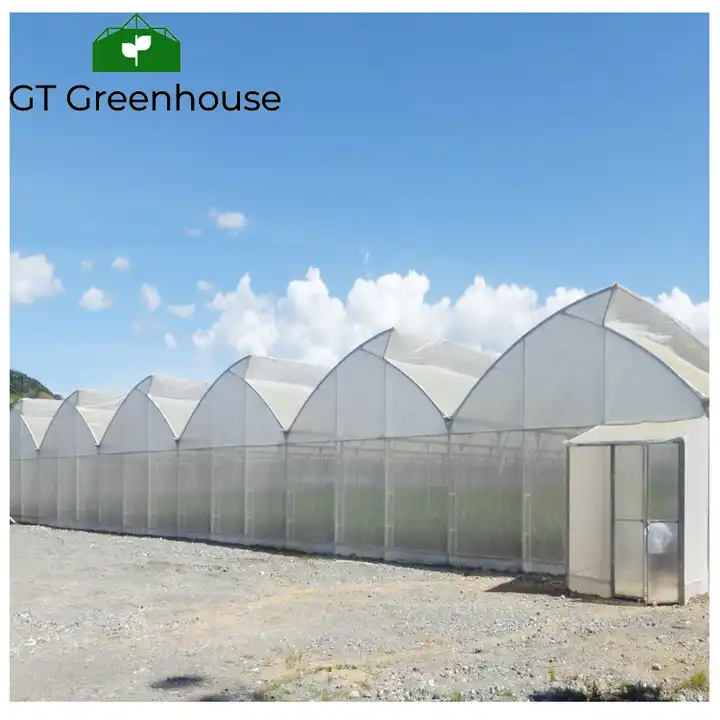A sawtooth greenhouse, also known as a sawtooth roof greenhouse, is a type of greenhouse structure that features a distinctive roof design resembling a series of saw teeth or zigzag patterns. It is named after the resemblance to the teeth of a saw blade. The roof of a sawtooth greenhouse consists of a series of sloping glass or plastic panels arranged in a repetitive sawtooth pattern.
Here are some key characteristics and advantages of a sawtooth greenhouse:
- Roof Design: The sawtooth roof design consists of a series of ridges and valleys, with each ridge comprising a vertical wall and a sloping roof panel. The alternating pattern creates a series of vertical windows or vents along the ridge, allowing for natural ventilation and light transmission.
- Ventilation and Cooling: The sawtooth design of the roof provides excellent natural ventilation. The vertical windows or vents along the ridges allow hot air to rise and escape, while cooler air enters through the lower sections. This airflow helps regulate temperature, reduce humidity, and prevent excessive heat buildup inside the greenhouse.
- Natural Light Distribution: The sloping roof panels of a sawtooth greenhouse allow for optimal light penetration and distribution throughout the greenhouse. The angled surfaces capture sunlight from different directions, maximizing the exposure of plants to natural light.
- Shading and Heat Control: The vertical walls of the sawtooth structure can be equipped with shading devices or shading systems to control the amount of sunlight entering the greenhouse. This helps prevent overheating and allows growers to adjust light levels based on the specific needs of the plants.
- Aesthetic Appeal: The sawtooth greenhouse design is visually appealing and adds an architectural element to the structure. It is often used in commercial greenhouse operations, botanical gardens, and educational facilities to create an attractive and unique greenhouse environment.
- Structural Strength: The sawtooth design provides structural stability and strength to the greenhouse. The alternating ridges and valleys distribute the weight of the roof evenly, ensuring the integrity of the structure.
- Space Utilization: The vertical walls of a sawtooth greenhouse provide additional usable growing space. Plants can be cultivated vertically along the walls, maximizing the use of available area and increasing the overall plant capacity.
Sawtooth greenhouses are commonly used in commercial horticulture, particularly for the cultivation of sensitive plants, flowers, and high-value crops. The design allows for efficient ventilation, light distribution, and temperature control, creating an optimal environment for plant growth. Additionally, the unique appearance of a sawtooth greenhouse can enhance the aesthetics of a greenhouse complex or garden setting.
When it comes to more information about the zigzag greenhouse,.
Here are some further details and related content:
- Energy Efficiency: The sawtooth design of the roof allows for effective natural lighting, reducing the reliance on artificial lighting during daylight hours. This can result in energy savings and lower operating costs for greenhouse operations.
- Temperature Regulation: The ventilation provided by the sawtooth design helps regulate temperature fluctuations inside the greenhouse. During hot periods, the hot air can escape through the vertical windows, preventing overheating and reducing the need for mechanical cooling systems. In colder weather, the greenhouse can be equipped with insulating materials or additional glazing to retain heat.
- Crop Flexibility: The design of a sawtooth greenhouse makes it suitable for a wide range of crops. The ability to control ventilation, lighting, and temperature allows growers to create optimal conditions for different plant varieties, including fruits, vegetables, flowers, and herbs.
- Commercial Applications: Sawtooth greenhouses are commonly used in commercial greenhouse operations, such as nurseries and horticultural production facilities. The design facilitates efficient growing practices, crop management, and harvesting operations in a commercial-scale setting.
- Climate Adaptability: The sawtooth design can be adapted to suit various climate conditions. For example, in warmer regions, the roof panels may have higher angles to maximize ventilation and cooling, while in colder regions, the angles might be adjusted to capture more sunlight and retain heat.
- Integration of Technology: Sawtooth greenhouses can incorporate advanced technologies to optimize crop production. This could include automated ventilation systems, environmental sensors, irrigation systems, and climate control systems to ensure precise monitoring and regulation of the growing environment.
- Research and Education: Sawtooth greenhouses are often utilized in research institutions, universities, and educational facilities for plant research and educational purposes. The design facilitates controlled experimentation and provides a visually appealing environment for studying plant growth and development.
- Maintenance Considerations: The design of a sawtooth greenhouse may require specific maintenance practices. Cleaning the sloping roof panels, ensuring proper sealing around the windows, and maintaining ventilation mechanisms are important for the efficient operation of the greenhouse.
It’s worth noting that while the sawtooth greenhouse design offers numerous benefits, it may not be suitable for all situations or budgets. Factors such as local climate, available space, cost, and specific crop requirements should be considered when deciding on the appropriate greenhouse structure for a given application.
